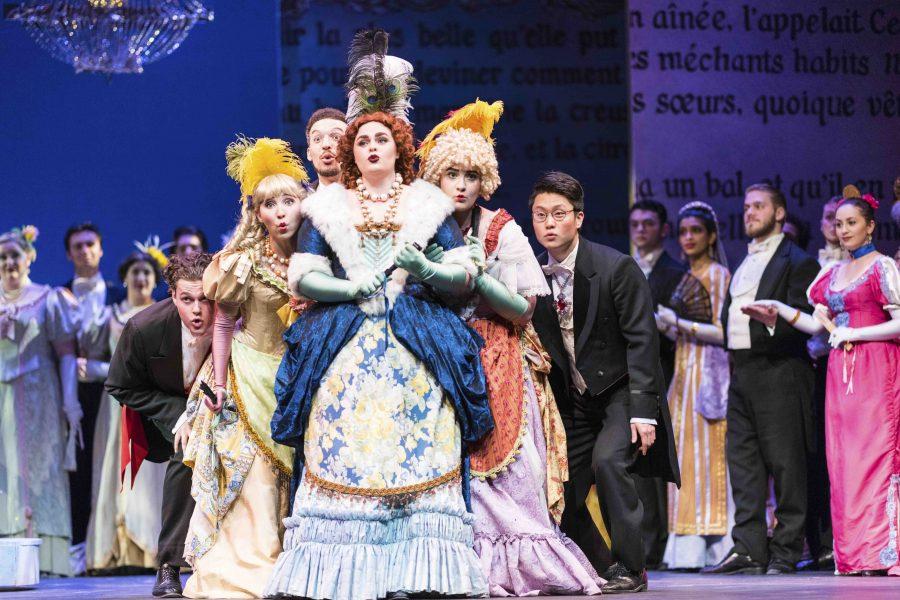‘Cendrillon’ Opera Charms with Quips, Fantasy
March 10, 2017
Editor’s note: This article contains spoilers.
With its production of Cendrillon, Oberlin Opera Theater invites audiences to join them in a world of fantasy, romance and stories that live beyond their pages. In this interpretation of the classic fairytale Cinderella, a score by Jules Massenet and a French libretto by Henri Caïn weave a rich atmosphere of non-reality from the moment that the first note is played.
The opera is accompanied by English superscript projected above the stage, which — aside from a few minor mistranslations — makes Caïn’s emotionally rich libretto accessible to an anglophone audience.
The opera’s prelude is playful — half dance, half game — which sets the stage for the entrance of the harried servants, Cendrillon’s father Pandolfe, the Countess and Cendrillon’s two stepsisters as they prepare for the palace ball. The personalities of these characters are taken to comical extremes — if they weren’t so funny, they would seem one-dimensional.
“[With] this character, I explore a part of me that I don’t really access at all — that nasty, unforgiving, [unreasonable] part,” said Conservatory sophomore Abigail Peterson, who will play the Countess today and Sunday. “There are no redeeming qualities in [the Countess] — she’s truly evil and selfish to her core.”
Early in the first act, the Countess tells her daughters that “what you read in books could happen to you,” which sets the tone for the rest of the opera. The role that books play in this production can hardly be overstated — the first time Cendrillon appears on stage, she is reading and has a stack of other books next to her, and the same is true of the Prince when we meet him in the second act.
Cendrillon, whose mournfulness stands in sharp contrast to the antics of her stepsisters, sings her first aria to her imaginary friends, impossible creatures that appear in her dreams to comfort her when she is alone. As we watch the first part of her story unfold, she is living in her own imaginary world.
“[Cendrillon] has been deeply hurt by the death of her mother and has taken refuge in books,” director Jonathon Field said. “This is from the original Perault version of the story. ”
The Prince’s reaction when people try to disturb his reading — ignoring them by lifting his book higher up — will immediately endear him to the readers in the room. Like Cendrillon, he reads to escape his loneliness.
The set itself is framed by two doors and a set of tall, moving panels with text printed on them, all of which give the impression that the opera itself is taking place within the pages of a book.
“Throughout [all the set changes], the recurring theme is pages from the French version of Grimm’s fairy tales,” said Gregory Ristow, OC ’01, the opera chorus master. “So in Act 1 Scene 1, if you look closely, the far left panel and the far right panel make up the split halves of the first page of Cendrillon in the French.”
Set designer Laura Carlson- Tarantowski created glorious set pieces for the three main settings in the opera — a fireplace for Cendrillon’s home, a staircase for the palace ballroom and an oak tree for the forest. Nothing on stage appears quite possible, but everything works to build the atmosphere of the story.
“We’re just trying to create a world that’s as romantic and as emotional as the music is,” Carlson-Tarantowski said.
The lighting design for the opera was a critical component, both for the showy effects, such as the repeated appearances and disappearances of the Fairy Godmother, and for more subtle emotional cues.
“We’re in [Cendrillon’s] house … and it’s cozy, it’s warm, there’s a fireplace, but … there’s this kind of starkness in the fact that she’s not equal to the rest [of the family],” said lighting designer Jeremy Benjamin.
The Fairy Godmother’s scenes are delightful, as she and her entourage of magical creatures enter in a twirling, shimmering dance.
“The Fairy Godmother and … the six ‘fairy assistants’ … have some of the most delightful music in the show as they’re getting [Cendrillon] ready for the ball,” Ristow said. “It’s straight out of Disney.”
When Cendrillon descends the staircase at the ball, she meets the Prince’s gaze, after which they have eyes only for each other. The pair sings the first of many charming treble duets, the Prince played by a dramatic soprano.
“There is a theme in the duet between the Prince and [Cendrillon] in the palace,” Field said. “She looks at him and sings ‘Vous êtes mon Prince Charmant’ [You are my Prince Charming], and that theme slowly expands into the duet. We hear the theme again for their duet in the woods, and she repeats it again when she comes back at the end of the opera. It is a simple theme, but really effective.”
After Cendrillon flees the ball at the stroke of midnight, she briefly reunites with the Prince underneath the Fairy Godmother’s magical oak tree. The backstage chorus gives an otherworldly feel to this scene, as though the night itself is singing. But after all this fantasy, the moment when Cendrillon and the Prince are allowed to see each other again is hauntingly real. The lovers are only allowed a brief moment together before they are separated, and Cendrillon even becomes convinced that the whole story was a dream. She then hears about the glass slipper and returns to the palace, where the Prince recognizes her.
The opera concludes with the cast breaking the fourth wall and singing that they “hope you enjoyed this trip to the land of imagination” directly out to the audience.





















